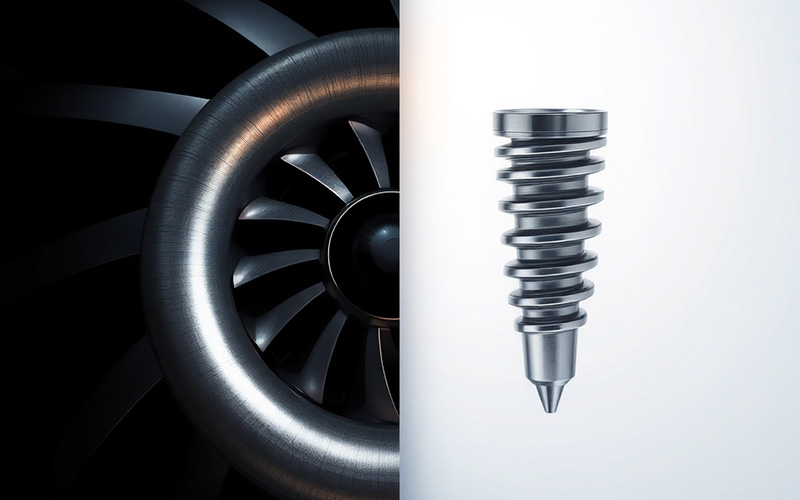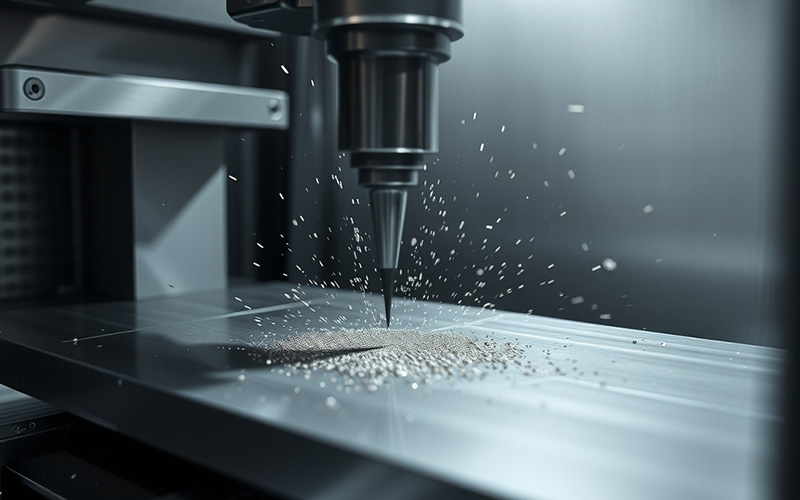Let Istar help you get started on your project with our experience and know-how!
Upload your design files and production requirements and we will get back to you within 30 minutes!

Titanium is very special. It’s as strong as some types of steel, but it is much lighter. It also does not rust. We are going to look at what makes titanium and its alloys so helpful. They are used for everything from airplanes to medical parts that go inside your body. Stay with me, and I’ll show you why this amazing metal is good to know about.
Let me tell you a story from way back in 1791. A man named William Gregor in Great Britain found some strange black sand near a stream. He was a church leader who studied rocks as a hobby. He saw that a magnet pulled on the sand. After he studied it, he found it had iron oxide. It also had another white metal oxide that he did not know. He had found a new chemical element. A few years later, in 1795, a German scientist named Martin Heinrich Klaproth found this element again on his own. He found it in a mineral called rutile. Klaproth gave it the name titanium. He named it after the powerful Titans of Greek mythology.
It’s funny to think that this very useful metal was around us for so long. It is the ninth most abundant element in the ground we walk on. You can find it in most igneous rocks and in dirt. Even though there is a lot of it, it took more than 100 years from when it was found before we could get titanium metal in a pure form. The first person to do this was Matthew A. Hunter in 1910. He found a way of heating titanium tetrachloride with sodium. This finally separated the pure metallic element. This shows how reactive titanium can be. It also shows why it was so hard to separate from other things.

When I talk about what titanium is like, I always start with its amazing strength for its weight. It has the best strength-to-weight ratio of any metallic element. In its pure state, pure titanium is as strong as some common types of steel. But it is a lot less heavy. This means you get a lot of strength without a lot of weight. It is a bit heavier than aluminum, but it is more than two times as strong as a very common aluminum alloy. On the periodic table, you will see titanium with the letters Ti. Its atomic number is 22. It is a transition metal, and that gives it some of its special features.
Having high strength and being light at the same time is a very big deal for many jobs. Think about it. You can make parts that are just as strong as steel parts but much lighter. This is very important in the aerospace world, where every pound you can save is helpful. But its good points do not stop there. Titanium is also easy to shape, especially when there is no oxygen around. It also has a high melting point. It is not good at carrying heat or electricity, which can be a good thing in some cases. These things that make titanium so special are what let us use titanium in so many great ways.
Getting pure titanium is not as easy as digging it up. The element is usually in minerals like ilmenite and rutile. The hard part is that titanium is very reactive, especially when it gets hot. It likes to join with oxygen, nitrogen, and carbon. Because it is so reactive, getting the metal out is a hard job. You cannot just melt it with carbon like you do with iron. That would make titanium carbide, not the pure metal we want.
The main way we do it today is called the Kroll process. It was created by William Kroll in the 1940s. It has many steps. It starts by making titanium tetrachloride from titanium ore. This liquid is then cleaned. Then, it is mixed with magnesium in a sealed oven at very high heat. The magnesium takes the chloride away. This leaves behind a material that looks like a sponge, called titanium sponge. This sponge is then crushed, pressed, and melted in a special furnace to make a solid block of metallic titanium. It is a hard and costly process. That is one reason why titanium and its alloys can cost more than other metals.
You might be surprised to know that most of the titanium ore we dig up is not used to make titanium metal. Most of it is used to make titanium dioxide (TiO2). This is a very bright white color powder. When you see bright white paint, plastics, paper, or even toothpaste, you are probably looking at titanium dioxide. It is very good at hiding or covering other colors. I have seen it used in everything from paint for houses to the coatings on medicine pills.
Besides being used as a white color, titanium dioxide has some other neat uses. As very tiny particles, it is used in sunscreens. It is very good at blocking bad UV rays from the sun. The titanium dioxide nanoparticles are so small that you cannot see them as white on your skin, but they still give great protection. It is also used to help clean the air and water. So, even though we often talk about the strength of titanium metal and alloys, the compound titanium oxide is a big part of our lives in ways we might not even see.
Pure titanium is great by itself. But we can make it even better by mixing it with other elements. This creates titanium alloys. An alloy is a metal mixed with other things to make it better. For titanium, we often add things like aluminum, vanadium, molybdenum, and nickel. Adding these can make the metal much stronger, tougher, and better performing. The most widely used of all titanium alloys is Grade 5. It is also known as Ti-6Al-4V. It has 6% aluminum and 4% vanadium.
There are different kinds of titanium alloys. The main ones are alpha, beta, and alpha-beta alloys. This just talks about how the atoms are set up inside the metal. It might sound a little technical, but this is what gives different titanium alloy grades their special features. For example, some alloys are made for very high strength. Others are made to work better in hot places or to have better corrosion resistance. By making these different titanium and titanium alloys, we can make the material just right for a certain job. It could be for a jet engine part or a medical implant.
When I think about titanium applications, the first thing I think of is aerospace. The people who make airplanes are always trying to make them lighter and use less fuel. This makes titanium a perfect material. Because it is strong but not heavy, titanium parts can be made lighter than steel parts but still be just as strong. About two-thirds of all titanium metal that is made is used in aircraft engines and bodies. You can find it in very important parts like the landing gear, engine parts, and the main frame of the plane.
How well jet engines work depends a lot on the materials they are made of. Engine parts need to handle very hot temperatures and a lot of stress. Titanium alloys are perfect for this. They keep their strength when they get hot and have great resistance to corrosion. This makes them great for the fan blades, discs, and cases in the engine. As new airplanes are designed with more new materials, the use of titanium will likely grow even more. This makes it a key material for flying today.
Yes, you can. And it is one of the most amazing applications of titanium. The human body can be a tough place for materials from the outside. But titanium is very friendly with the body. This means it is not poison and the body does not try to fight it. In fact, the body accepts it so well that bone can actually grow onto a titanium implant. This is called osseointegration. This special power makes titanium implants very steady and long-lasting.
You will see titanium being widely used in hospitals. It is used for things like hip and knee replacements, bone plates and screws, and fake teeth roots. Pacemaker cases and other devices that go inside the body are also often made of titanium. This is because it has great corrosion resistance against fluids in the body. Another big plus is that magnets do not pull on titanium. This means that people with titanium implants can safely get MRI scans. The use of this great metal in medicine has made life much better for millions of people.

Not all titanium is the same. To help people choose the right material, titanium is put into different grades. The grades of titanium are put into two main groups: commercially pure titanium and titanium alloys. The pure grades are numbered 1 through 4. Grade 1 is the softest and easiest to shape. This makes it great for jobs that need a lot of bending. As you go up to Grade 4, the strength gets higher.
The alloy grades are where it gets really neat. There are many different titanium alloy grades. Each one has a special recipe of other elements added to it to get certain features.
| Grade | Common Name | Key Features |
|---|---|---|
| Grade 5 | Ti-6Al-4V | The most common alloy, with high strength and good ability to be shaped. |
| Grade 7 | Ti-0.15Pd | Like Grade 2 but with palladium added for the best corrosion resistance. |
| Grade 12 | Ti-0.3Mo-0.8Ni | Has molybdenum and nickel for more strength and corrosion resistance. |
| Grade 23 | Ti-6Al-4V ELI | A purer kind of Grade 5, often used for medical titanium implants. |
Picking the right titanium grade is very important for any job. You have to find a good mix of strength, how well it fights rust, and how easy the material is to work with.
One of the best things about titanium is its amazing corrosion resistance. This metal is very resistant to corrosion from seawater, chlorine, and many types of acid. The secret to this is a very thin, clear layer of titanium dioxide (an oxide film). This layer forms on its surface when it touches oxygen. This protective oxide layer is very strong, tough, and can fix itself. If the surface gets a scratch, a new layer forms right away as long as there is a little bit of oxygen or water around.
This protective film is stronger than the one that forms on stainless steel. This is why titanium often works better in tough places that can cause other metals to get small holes or cracks from corrosion. This great resistance to corrosion is a big reason why titanium is so prized for use in the ocean, in chemical processing factories, and in plants that make fresh water from salt water. It is a tough metal that can handle some of the hardest jobs without any problems.
Even though it is known for its use in aerospace and medicine, you might be surprised to find titanium in many things you use every day. Because it is strong, light, and does not cause skin allergies, it is a popular pick for jewelry and glasses frames. You will often see “titanium” written on expensive glasses. This is because the frames are easy to wear, they last a long time, and they will not bother your skin.
The world of sports also loves titanium. Its high strength for its low weight is perfect for making sports gear that works great.
From helping us see better to making our golf game better, the special properties that make titanium so good for high-tech jobs also help us in our daily lives.